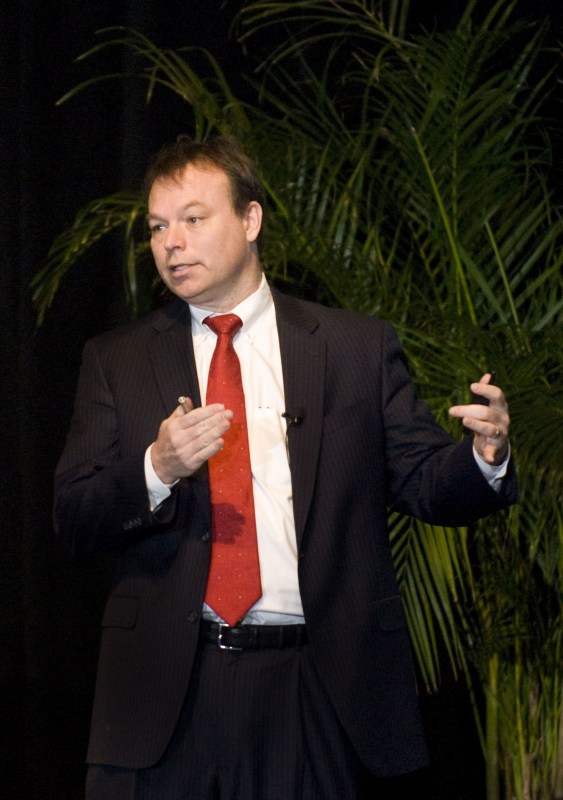
Jeff Balser, M.D., Ph.D., talks about Medical Center goals at last week’s Leadership Assembly. (photo by Susan Urmy)
Personalized medicine highlights leadership meet
Advances in personalized medicine and informational technology took center stage at last week's Vanderbilt University Medical Center spring leadership assembly, held in Langford Auditorium.
According to Jeff Balser, M.D., Ph.D., vice chancellor for Health Affairs and dean of the School of Medicine, Vanderbilt is uniquely poised to be a national leader in both areas.
“We're rapidly approaching the day when patients can be offered DNA sequencing, and the electronic medical record will then contain essential information that guides their care when they need it,” Balser said.
As a likely early gain under personalized medicine, he gave the example of safer anticoagulant dosing based on patients' DNA signatures.
“It will happen at Vanderbilt first, and then it will start to happen other places. That's what we have to do, not just get it done here, but move it across the country,” Balser said.
C. Wright Pinson, M.D., MBA, deputy vice chancellor for Health Affairs and senior associate dean for Clinical Affairs, provided updates on people, service and quality.
Based on the most recent employee satisfaction survey, he said VUMC is redesigning work processes with an eye to ensuring sustainable staff work loads, encouraging leaders to visit more routinely with front-line staff, and reviewing compensation levels and HR practices and policies.
A key service goal this year is scheduling new patient appointments within 15 days, 60 percent of the time. Progress is steady, Pinson said, and “the message is getting around: this is what we expect, this is the norm for this organization.
“We are focusing on what the patient needs, not what is convenient for us, and we are making Vanderbilt more accessible.”
Pinson commended the cardiovascular intensive care unit for instituting patient transport “timeouts,” and he commended the 6 North neurosciences unit for reducing patient falls by 70 percent.
Regarding hand hygiene, he said it's the job of health care professionals to talk to each other about hand washing, and the right answer, when someone reminds you to wash your hands, is “thank you.”
Pinson also asked for continued support for evidence-based care bundles, universal protocol and patient handover education, hand hygiene vigilance and targeted mortality improvement efforts.
Bill Stead, M.D., associate vice chancellor and chief strategy and information officer, gave a presentation that Pinson characterized as “innovation 101.”
Above all, innovation is concerned with dramatic improvements in value, Stead said. “When you think about innovation, you really need to think about, 'how do we increase the number of people we can take care of … while decreasing the cost per patient.'”
Innovation is high risk by its very nature, Stead said, and projects are best kept to a modest scale until their value is proven.
Proof-of-concept projects are under way for team-based chronic disease management and warfarin management, among other projects.
Jim Jirjis, M.D., MBA, chief medical information officer and medical director of Adult Primary Care, outlined MyHealthTeam at Vanderbilt, an innovative model of ambulatory care combining team-based care with telemedicine.
He presented a strategy for boosting hypertension control by better than 60 percent within five years, all while doubling patient capacity.
The thinking is that payers will come around to funding the team concept as cost benefits are proven.
“Over time we intend to create a different business model for health care at this Medical Center,” Stead said.
The half-day assembly was attended by approximately 800 managers and faculty leaders. To view the presentations, visit the elevate Web site (employee log-in required).













